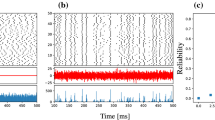Abstract
The properties of a mathematical model of a nuclear pore complex are studied using a random cap process on a two-dimensional Euclidean sphere of unit radius. The results obtained make it possible to calculate stereometric characteristics of a nuclear pore complexes from electron-diffraction patterns.
Similar content being viewed by others
References
L. C. Gorsch, T. C. Dockendorff, and C. N. Cole, “A conditional allele of the novel repeat-containing yeast nucleoporin RAT7/NUP159 causes both rapid cessation of mRNA export and reversible clustering of nuclear pore complexes,” J. Cell Biol., No. 129, 939–955 (1995).
P. Grandi, N. Schlaich, H. Tekotte, and E. Hurt, “Functional interaction of Nic96p with a core nucleoporin complex consisting of Nsp1p, Nup49p and a novel protein Nup57p,” Embo J., 14, No. 1, 76–87 (1995).
M. S. Lee, M. Henry, and P. A. Silver, “A protein that shuttles between the nucleus and the cytoplasm is an important mediator of RNA export,” Genes Dev., No. 10, 1233–1246 (1996).
M. W. Goldberg and T. D. Allen, “High resolution scanning electron microscopy of the nuclear envelope: demonstration of a new regular, fibrous lattice attached to the baskets of the nuclear pores,” J. Cell. Biol, 119, No. 6, 1429–1440 (1997).
M. E. Hurwitz, C. Strambio-de-Castillia, and G. Blobel, “Two yeast nuclear pore complex proteins involved in mRNA export form a cytoplasmically oriented subcomplex,” Proc. Nat. Acad. Sci. USA, No. 95, 11241–11245 (1998).
F. Stutz, A. Bachi, T. Doerks, I. C. Braun, B. Seraphin, M. Wilm, P. Bork, and E. Izaurralde, “REF, an evolutionary conserved family of hnRNP-like proteins, interacts with TAP/Mex67p and participates in mRNA nuclear export,” RNA, No. 6, 638–650 (2000).
E. P. Lei, H. Krebber, and P. A. Silver, “Messenger RNAs are recruited for nuclear export during transcription,” Genes Dev., No. 15, 1771–1782 (2001).
H. J. Vogel and K. Roth, “Quantitative morphology and network representation of soil pore structure,” Adv. Water Res., No. 24, 233–242 (2001).
H. L. Wiegand, G. A. Coburn, Y. Zeng, Y. Kang, H. P. Bogerd, and B. R. Cullen, “Formation of Tap/NXT1 heterodimers activates Tap-dependent nuclear mRNA export by enhancing recruitment to nuclear pore complexes,” Mol. Cell. Biol., No. 22, 245–256 (2002).
K. S. Kabak, Yu. I. Petunin, V. P. Yatsenko, and N. G. Semeiko, “Pore density of receptor neuron’s envelope in early ontogenesis of Gallus domesticus L,” Arkhiv Anatom., Gistol. Embriol., 75, No. 9, 101–106 (1978).
K. S. Kabak, Yu. I. Petunin, V. P. Yatsenko, and N. G. Semeiko, “Probabilistic-statistical analysis of the pore complex of the nuclear envelope of an afferent neuron,” Abstracts of Papers Read at the 1st All-Union Conf. on Statist. Properties of Microstructures, June 5–9, 1978 [in Russian], ONTITEIMikrobioprom, Moscow (1978), pp. 163–164.
Yu. I. Petunin and N.G. Semeiko, “Random process of segments on a two-dimensional Euclidean sphere. II,” Teor. Veroyatn. Mat. Statist., Issue 41, 88–96 (1989).
Yu. I. Petunin and N. G. Semeiko, “Calculating the first-order moment measure of a random process of segments on a two-dimensional Euclidean sphere,” Teor. Veroyatn. Mat. Statist., Issue 42, 114–122 (1990).
Yu. I. Petunin and N. G. Semeiko, “Random process of segments and the generalized Wicksell problem,” Proc. 1st All-Union Congr. of the Bernoulli Society, Sept. 8–14, 1986, Tashkent [in Russian], 2, p. 748 (1986).
Yu. I. Petunin and N. G. Semeiko, “Random cap process and generalized Wicksell problem on the surface of a sphere,” SERDICA, 17, 81–91 (1991).
K. R. Clark, “Statistical techniques in stereology,” Communic. Statist., 106, No. 15, 1459–1478 (1981).
K. Weibel, Practical Methods for Biological Morphometry, Vol. 1: Stereological Methods, Academic Press, London (1980).
S. D. Wicksell, “The corpuscle problem. Part 1,” Biometrika, 17, 84–99 (1925).
G. Korn and T. Korn, A Reference Book on Mathematics for Scientists and Engineers [in Russian], Nauka, Moscow (1968).
V. I. Psarev and V. I. Parkhomenko, “Computer-assisted dispersion analysis of porosity variation in metals,” Cybern. Syst. Analysis, Vol. 41, No. 5, 783–788 (2005).
Author information
Authors and Affiliations
Additional information
__________
Translated from Kibernetika i Sistemnyi Analiz, No. 6, pp. 175–182, November–December 2006.
Rights and permissions
About this article
Cite this article
Semeiko, N.G., Petunin, Y.I. & Yatsenko, V.P. Studying the morphometric characteristics of nuclear pore complexes of a sensory neuron using methods of spherical stochastic geometry. Cybern Syst Anal 42, 917–922 (2006). https://doi.org/10.1007/s10559-006-0131-2
Received:
Issue Date:
DOI: https://doi.org/10.1007/s10559-006-0131-2




